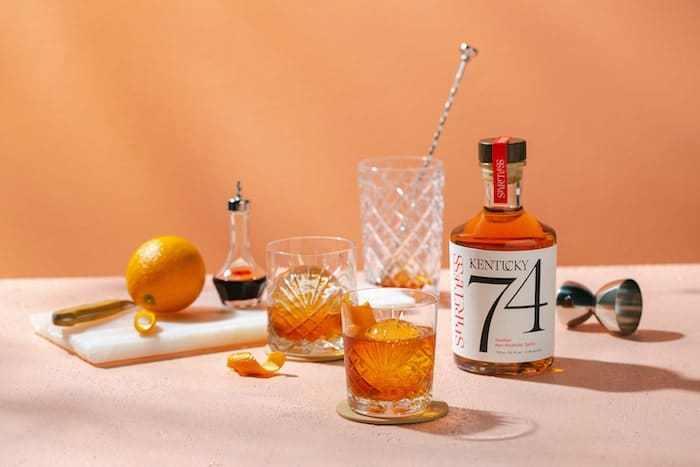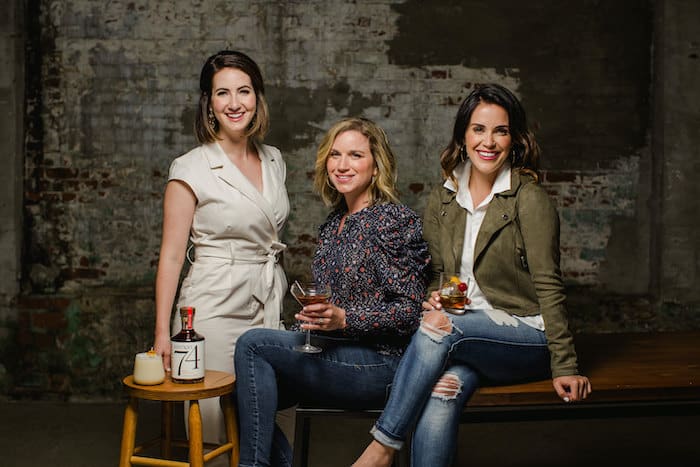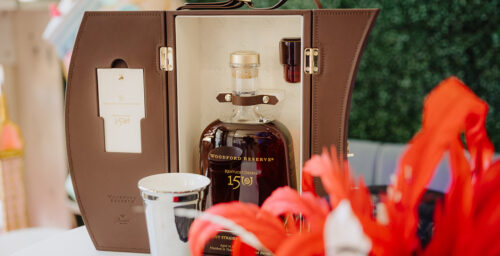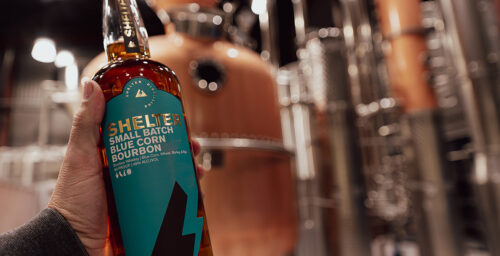For a percentage of people who go out on the town with friends, having an alcoholic beverage in hand is something they, for whatever reason, do not want to have. Until recent times this thus meant either having some kind of basic “mocktail” or a soda of some type. This gap in the market created an entry point, and thus was born the world of non-alcoholic spirits.
What exists today in this space is a rather bizarre hodgepodge of offerings, some of which are decent quality and some of which are best described as being glorified paint thinner. Certainly not something that would appeal to most whiskey drinkers, and unfortunately something which, once again, leaves non-alcoholic drinkers with not the best tasting choices.
Enter thus in very recent times a small wave of companies that are trying to find ways to make their non-alcoholic products be more flavorful, especially in close comparison to the range of flavors something like a typical bourbon might offer. One of these is Spiritless, based out of Louisville, Kentucky. Their first product out the gate is Kentucky 74, described by them as a “non-alcoholic bourbon” that’s designed to “be used as a delicious option to go booze-free or to lower the ABV in mixed drinks.”
Using what the company describes as an “advanced, innovative formulation process,” Spiritless believes they’ve created “an authentic bourbon-like spirit, underpinned by familiar, whiskey-warmed notes of caramel, vanilla, and oak.” To learn more about this, we recently spoke with two of the three company’s co-founders – Lauren Chitwood, CEO, and Lexie Larsen, COO – to learn more about the company and their non-alcoholic, whiskey-like product.
Note, as always, this interview has been edited for clarity and brevity.

The Whiskey Wash (TWW): So we thought we might first start chatting a little bit just about the non-ABV spirits market in general, just to get your kind of take on that. It seems to definitely be an emerging trend, and something particularly in the whiskey-like space that has some interesting ideas to it. What is the spirit-like space, and how did it come about?
Lauren Chitwood: We’ve been working in the spirits business and the hospitality business, one way or another, across the better part of a decade, between us. And I think that, while the trends of consumption historically are very cyclical, and you can kind of see that over the course of history, one of the things that we are noticing now, which I truly believe, is heightened by the growing awareness of wellness, and a variety of things, is that frankly, people, most specifically millennial and Gen Zs, are drinking considerably less.
They are also choosing to be more empowered in their consumption. I think one of the things that we also see and know to be true is these generations are also kind of able to hold this idea as not necessarily an all or nothing sort of rule, right? So people are acting, probably, frankly, in a more reasonable way, where it’s maybe about being more conscious during the week, and consuming one night on the weekends, or things like that. So frankly, it’s a growing trend that we saw and decided to jump on.
TWW: Talk a little about the formation of Spiritless and what it took to bring your company together.
Chitwood: It’s interesting that [an] aha [moment] happened for all of us sort of at the same time, but as we were working on large activations and large festivals, we obviously worked very closely with spirits companies and lifestyle brands prior to this. And there was always a kind of an 11th hour 911 that kept arising, where either it was from the consumer side or from the spirit side, [where] people were really demanding something non-alcoholic that was elevated. That was an option other than soda and lime, or a bottle of water or diet Coke.
As we were fielding these requests and working with mixologists and that kind of people in the trade on how to solve for this, for this constant need that kept arising, we just all looked at each other, and just said, “Well, maybe we should solve this problem for real this time.”
And so that’s really how it happened. That was in late summer and early fall of last year. So 2019, and we really felt like bourbon or a bourbon-like product, whiskey-like product, was really the place to start, as it really kind of spoke to what we knew, being from Louisville.
TWW: Talk about the product specifically. What is it and what are you trying to model it after? Also, how did you create it?
Chitwood: Essentially when we looked at the space, kind of a cursory search that anyone can do, you’ll see a lot of clear products. So a lot of gin-like, vodka-like products, and frankly from a strategy perspective, one, because we were really in kind of the hotbed of distilling and bourbon, but two, because it was what was really what we felt like was the most unrepresented in the marketplace, we decided to start with something that was similar to the Kentucky native spirit that we know and love.
When we were solving for that, we also were really solving, frankly, our own problem, right? Which was we are three type A females that start early and go late. We wanted something to be able to enjoy on a Tuesday night at a business dinner. And we also wanted something that blended really beautifully, that gave us flexibility. So what we’ve done is we’ve created a non-alcoholic spirit that has very familiar notes of oak, smoke, vanilla, caramel, things that you will find very reminiscent of a bourbon-like product.
And with that, what we’re able to do is go completely spiritless, to be able to [fit with] your favorite bourbon cocktails, and/or be able to blend with a full proof spirit. So that was really important to us because we, again, are drinkers. We’re not religiously sober daily. So the idea for us to be able to have something that was able to lower the ABV and lower the calories, while still having a little bit of alcohol, was really important to us as well.
We’ve very fine tuned, crafted that spirit to be able to do that. And frankly, I think that is the largest use case that we are seeing. As we talk to consumers and they try the products, we make them halfsies cocktails, is what we call them. We’re ordering in halfsies, we’re serving it halfsies. We’re taking one ounce of full proof bourbon of your choice and one ounce of Kentucky 74, and what they’re seeing is that they’re enjoying an Old Fashioned for 50 or 60 calories by comparison. And that really all the taste and flavor are there.

Lexie Larsen: [With regards to the product development], let’s start from the start. We started with some really rudimentary equipment. We’re talking about a stock pot, some PVC pipe with a two way water pump and an ice cooler. We were trying to sort of, in a really janky, jerry-rigged way, prove to ourselves that we could take a full proof spirit and we could make it a lower and no proof spirit. And the question or the hypothesis was, what does that do to the flavor? What can withstand reverse distillation?
After much trial and error, we got to a place where we felt confident in understanding how to control our temperature, our pressure, vapor capture, all of those things. And we got to a place where we felt like we had proof enough that this path could be fruitful.
We then sought guidance and input and advisement from all of our friends and buddies, and our neighbors in the bourbon industry, and we got a lot of support, but were also met with a lot of, “Why would you do that?” And “That’s the really hard way to do it, ladies, and I don’t understand what you’re trying to achieve.” And I think a lot of that came from trying to give us good advice, but what they couldn’t do was pull up from the problem enough to see the solution that we were trying to be met with.
Ultimately we found a great partner who had a lot of experience in distilling, who was younger, she was female. It felt like a a great addition to the team during research and development. She was able to help us really fine-tune our process.
The two big things that we were trying to solve for were mouthfeel, and of course, trying to get this to be in a place where it felt like we would pacify that sort of health conscious lifestyle. We [also] wanted it to be authentic, so instead of just going to a flavor house and saying, “Hey guys, this is what we want to do. What can you cook up for me,”we wanted to pay homage and give an ode to the distilling history which is so rich in Kentucky.
We ended up with a two part process. The first part of the process is called fractional extraction. With this extraction, what we’re doing is we’re using temperature control, pressure control, and time control. And we really tune in on those variables in a very precise way. We extract using grain neutral spirit and a variety of oak in a couple of different chars.
We then emulate the process that you think about happening in a rickhouse when you’re aging a spirit – the atmospheric temperatures and the weather is what sort of makes that spirit interact with that barrel. It goes in and out of the wood, and that’s how those flavors really get turned into the spirit. We wanted to accelerate that process by doing it on our still, sort of oscillate those temperatures to make all the flavors of the oak really unite with the spirit.
From that extraction, we get a really high proof, really intensely flavored spirit. It’s like a quadruple oak spirit, if you can even imagine a bourbon that was just so intense that all the flavors really came through. And the reason we had to do this was because the second part of the process is something pretty intense to flavor molecules, so we needed something robust enough molecularly, and qualitatively from a flavor perspective, that could survive part two, which is reverse distillation.
And reverse distillation is exactly like what it sounds. It’s exactly reverse of a normal distillation. So we put our high proof, quadruple oak concentrated spirit into a second still, and we go ahead and distill off the ethanol. Once all the ethanol and esters are cooked off, we retain what’s left in the still, which is a pretty incredible concentrate of bourbon-like flavors. And that’s the base of our spirit.
A question we get a lot, of course, is, “Okay, you took the ethanol out. So how do you keep it? How do you keep it in the bottle and shelf stable? And what does that look like?” So of course, when you lose ethanol and you lose those esters, you have to get creative, right? So we use some citric acid to help keep our pH at a good, stable level. And we use just a touch of all-natural cane sugar, and that helps us stay on a shelf open for 12 months.
TWW: So there’s no traditional barrel aging that goes on with this, given the type of product it is, correct?
Larsen: No, there’s not. We’re literally taking chunks of barrel and using that in that first extraction component.
Chitwood: For us, the problem to solve, and kind of leaning on the relationships that we have in the food and beverage industry from our tenure, we did an assessment on like, what are people solving for in this space, and what are the complexities, what are people unsatisfied with? I think the consistent, resounding feedback was, stuff might smell like a spirit, it might smell like something that we recognize, but most of it falls apart in the glass. It drinks like water once you make a cocktail.
When we allowed ourselves to kind of step back and say, “Okay, we’re solving for this, right. We’re solving for something that has enough flavor, enough mouthfeel, enough of a warming sensation, those things that you really recognize in your palate when you’re drinking a cocktail, how do we make that?”
We were solving for that in a way that feels incredibly nontraditional to the spirit space. What we have absolutely done is solve the problem, which is to say we have something that truly lingers, that gives your palate that full experience, that, compared to other non-alcohol products, is really [something] others have not been able to.
TWW: Is this a product that can be drank on its own like a regular whiskey, or is it something that really needs a cocktail to find its full potential?
Chitwood: It depends on the person. I fervently believe that my very serious bourbon connoisseurs, the gentlemen that are, and ladies, that are sipping neat out of a Glencairn consistently, are probably never having the desire to sip us neat. I just think that if you really enjoy the punch in the mouth and the intensity of that experience, that is certainly not what you’re going to get here.
Now, on the contrary to that, we have customers who are sober daily, right? That feel like they are comfortable having a alcohol-like experience that is non-alcoholic consistently, and that doesn’t push any boundaries for them. And they are absolutely sipping it neat. They’re enjoying it. They like what it looks like in their glass neat. It is something that has a taste that is authentic enough that you don’t need to blend it with other things for it to be palatable.
And so I think that’s really the answer, that it depends. I think for your serious whiskey guys, they’re going to go, “I don’t get it. Not neat for me,” but we are seeing people sipping it neat and they’re thrilled by it.
TWW: In cocktails, what kind of cocktails do you envision it being in? Something that a type of whiskey would classically pair to a cocktail? Or do you think it can go beyond that?
Larsen: I think that we were solving the easy, approachable cocktails when we started this journey. So certainly making an Old Fashioned, making a low ABV Manhattan. What’s really great is when you make a Whiskey Sour with all that sugar and all that citrus, you still get those deep whiskey notes, which is one of my favorite ways to drink it.
I think that we are excited to see the mixology world get their hands on this. And I certainly think that there are going to be new cocktails born that are beyond what a traditional bourbon whiskey would be used for, that will see this appear in.
TWW: Is this product 100% alcohol-free? Or is there a touch of alcohol in it?
Larsen: It is not 100% alcohol-free – it is 0.5% ABV or below. We measure our product really consistently. Our quality control is super tight, to make sure that we are keeping it at that level.
Looking at the landscape of non-alcoholic spirits and beverages, there are a lot that are 0.0. And we certainly understand that the 0.5 is a differentiator for us, but it’s not there just because there’s a very intentional process, right? So we went into it, knowing that we wanted to sort of measure right up to that non-alcoholic level.
The FDA tells us that as long as you are 0.5 or below, you’re considered non-alcoholic. And so we used every bit of that 0.5 to give as much mouth feel as we possibly could. We really use that ABV super intentionally.
TWW: When we think about traditional whiskey, we think about it having a mash bill. What’s the case with your product?
Larsen: We get a lot of questions about mash bill, and I think it’s important to remember what we’re doing here. It was interesting evolution, even for our team. We set out and we also only knew bourbon whiskey to be what it is, which is abiding by all of those guidelines. And I think as we started to sort of peel back the layers of innovation here, we just kind of said, “Gosh, why do we, the innovators, feel such a need to follow all these rules? And if we’re going to break one, we’re already disqualified from being in the party. Why be beholden to the rest of them?”
So I think how we really looked at it was how can we do this to bring the most authentic flavor to life, and let’s throw out all of those things we know to be true about our favorite bourbons that we love and respect, and look at this as a problem to solve.
Because of that, we sort of threw out the mash bill – we’re not following all the guidelines about how much corn and how many years in a rickhouse and what proof it goes in barrel because those things are not relevant to us.
TWW: With this product, is this the only one you are planning on releasing? Or do you have other things in mind that you might want to release down the pipe?
Chitwood: Right now we are in development on both gin and tequila, as we speak. We’ve got teams that are working closely on those innovations, and our big goal is to be really the product and the category leader in the space. We want you to be able to sit at any bar, whether it’s in little old Louisville, Kentucky, or somewhere in Europe, and be able to say, “I’d like a Paloma or a Manhattan or G and T, and I want to order it Spiritless.”









